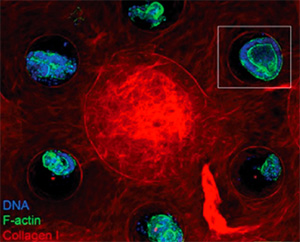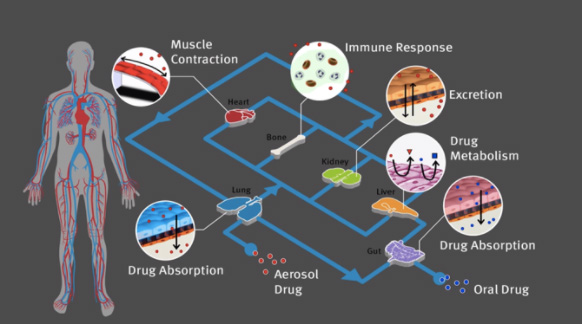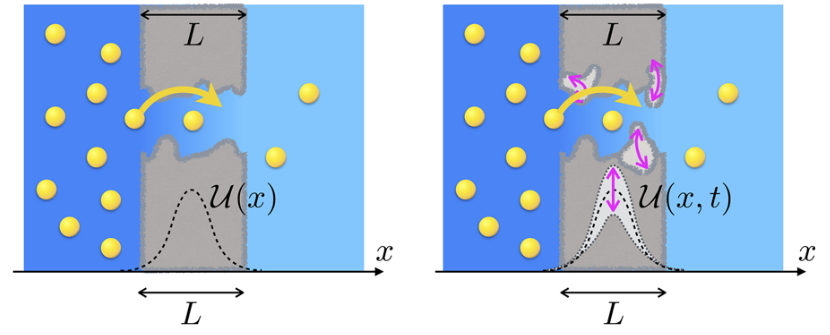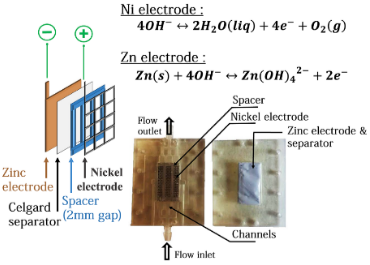Who has never thought about lessening side effect induced by drugs? About personalizing treatment for each human? And why not eradicating drug tests on animals? These thought were dreams, then expectations, and are now concrete driving forces to build an entire platform within which all live organs from human body are connected each other to form a complex in vivo-like network, for drug screening and personalized medicine. That is called: human-on-a-chip.
Currently, worldwide researchers are developing microfluidic organ-on-chip to reconstruct live and vascularized organs such as skin, liver, gut, spleen, lymph nodes, lung among others. Tissue engineering technologies aim to build those chips to better understand the physiological but also pathological state of live organs. Revolutionary platforms for disease comprehension and treatment are currently based on microfluidic organ-on-chip technologies. Thus, what are they?
A the organ level, on-going projects: Mimicking live organs requires to model the 3D structure of live organs, their function hence the different cell types in the organ, and the forces that cells or cellular tissue experienced. The microfluidic technologies allow a fine control of (i) flows into the chips such as their speed, shear forces, (ii) the cell types and concentration, their ability to migrate, to flow, to adhere on substrates, and (iii) the biochemical environment such as type of soluble molecules (chemokines, cytokines for instance), their concentration, presence or absence of gradient.
Their development require to fully understand each detail of cell-cell interaction within a cellular tissue or between a circulating cell (blood cells) and a tissue cell (epithelium for instance) - Are cell adhering? How much?, to measure the impact of forces needed to mimic an organ - Do stretching or compressive forces induce in vivo-like behaviors?, to control the flow that cells experience – Is shear stress high or low enough to not alter cell viability or ensure good nutrient replenishment? All those questions necessitate to back and forth between model and live human organs.

Stephanie Descroix’s (MMBM, Institut Curie) and Ayako Amada’s (NBMS, ENS-PSL) teams currently work on gut-on-chip, kidney-on-chip, alveolar-on-chip, to mimic and understand the in vivo microenvironment of organs and then identify how they react to external stimuli such as stretching/compressing gut-on-chip and screen drugs (Fig. 1). Also, their device reveals the interplay between tightly packed renal tubes, constituting a promising tool to further study kidney pathophysiology [1-3].
Figure 1: Microscopy image of a 3D gut-on-chip. Scale bar: 150 µm [3] - From MMBM lab.

At the human level, a revolutionary project: The final aim consists in screening drugs for personalized medicine (drug types and concentration), finding the most non-invasive treatment for each patient, and testing potential local and global side-effects, and replacing usual test on animal (from mice to pig or monkey). The organ-on-chip studies are the origins to further built a highly advanced chip combining several organs-on-chips, connected with lymph and blood vessels-like canals within which live cells, molecules, and eventually drugs circulate. They bring important insights to build a crucial breakthrough for a the 2k50 medicine. Imagine a miniaturized human, containing every cells of your body, on your hands. It is a close future that researchers are building (Fig. 2).
Figure 2: Scheme of a human-on-chip global project. Image from Wyss Institute.
[1] S. Myriam et al., A multitubular kidney-on-chip to decipher pathophysiological mechanisms in renal cystic diseases, Front Bioeng Biotechnol, 26(9):624553 (2020)
[2] M. Nguyen et al., Dissecting Effects of Anti-cancer Drugs and Cancer-Associated Fibroblasts by On-Chip Reconstitution of Immunocompetent Tumor Microenvironments. Cell Reports, 25(13):3884-3893 (2018)
[3] M. Verhusel et al., Developing an advanced gut on chip model enabling the study of epithelial cell/fibroblast interactions, Lab-on-chip, 21(2), 365-377 (2021)
See more:
Lab-On-Chip (LOC)
Lab on a chip is an entire screening platform or a microreactor device used to analyze substances, or create products, with a few reagents, low-cost and portable. Imagine! A simple, fast and trustworthy microfluidic chip caring in our pocket for liquid and gas sample analyses.

One of this technology is currently an on-going project in the Joelle Vinh’s team (SMBP, ESPCI-PSL). The protein analyses is of a crucial research field for deeper understanding the diseases ensured by an over or down regulation of protein expression. Usually, these studies require long and heavy preparation steps before analysing samples into liquid chromatography coupled with mass spectrography technique: protein extraction from cells, protein linearization, washing steps, and the one-night enzymatic protein digestion! The whole preparation requires at least 30h.
Using microfluidic techniques, the SMBP team imagined
and developed a chip within which they inserted a molecular filtration
membrane for protein sample preparation miniaturization. The proteins
are extracted, chemically processed, rinsed and digested into peptides
in the chip. Generated peptides are directly sent into the
chromatography system for trapping and separation reducing
significatively molecular loss. The result is astonished: researchers
can now use 33-fold less cells compared to usual preparation methods,
for more robustness in protein identification. This technology reduces
the risk related to protein study of pathogenic microorganisms, and
allows protein analysis of diluted and gas samples.
This current revolutionary development opens up to miniaturized, portable and ease-handled chip for blood, polluted water or air sample analyses, and air/water filtration. Imagine! A whole lab-on-a-chip soon in our hands (Fig. 3) [4].
[4] M. M Ndiaye et al., On-Chip Sample Preparation Using a ChipFilter Coupled to NanoLC-MS/MS for Bottom-Up Proteomics, Journal of proteome research, 19(7):2654-2663 (2020).
From microfluidics to ... Nanofluidics !
Ready to go down to 1000-fold smaller than microscale resolution? Do you think measuring water molecules, mass and ionic transport is unreachable? Not for Lydéric Boquet’s team (MicroMegas, ENS-PSL).
Water treatment is a major issue in our modern society. The population's need for water is growing rapidly and is linked in particular to the demographic evolution of the last few years, while the sources of drinking water are increasingly polluted, in particular due to the growing industrialization. The challenge is to be able to treat drinking water sources (need for ultrafiltration to filter out traces of micropollutants) as well as to be able to desalinate sea water, which comprises 97% of the water present on earth. However, the existing processes are extremely expensive.
 Figure 4: Membranes as
potential barriers. (Left) Porous membrane seen as an energy barrier
U(x). (Right) The porous membrane has some temporal dependence
(forinstance, time-dependent porous aperture) and can be seen as a time
dependentenergy barrier U(x,t) [5]. - From MicroMegas lab.
Figure 4: Membranes as
potential barriers. (Left) Porous membrane seen as an energy barrier
U(x). (Right) The porous membrane has some temporal dependence
(forinstance, time-dependent porous aperture) and can be seen as a time
dependentenergy barrier U(x,t) [5]. - From MicroMegas lab.
Lydéric Boquet's team (MicroMegas, ENS-PSL) is therefore interested in the development of innovative processes that are currently functional at the laboratory scale. These systems allow water treatment at lower energy costs and are, in general, less restrictive than conventional technologies. Their operation is based on the phenomena of ion transport through nanometric pore membranes, optimized for water transport and selectivity of pollutants and salts, whose ultimate goal is to depollute water and desalinate seawater (Fig. 4) [5].
More practically, MicroMegas team is interested in the understanding and the physical description of transport phenomena at the nanoscale such as nanopores and carbon nanotubes. Its theoretical description is accompanied by a strong experimental expertise on atomic force microscopy (AFM), in order to describe and create new nano-materials, and to experimentally validate the fundamental and theoretical models they develop.
[5] S. Marbach, N. Kavokine, and L. Bocquet, Resonant osmosis across active switchable membranes, Journal of Chemical Physics, 152, 054704 (2020)
2k50 Batteries
The development of durable, high-performance storage systems, such as batteries, is a key element of the energy transition. They must allow the storage of energy produced by renewable sources, and in another register, they govern the performance of the electric vehicle in both autonomy and recharge time.

Figure 5: Sketches of a Zinc Cell and its components. [6]. - From MIE lab. (Instagram post)
Annie Colin's team (MIE, ESPCI-PSL) is working on understanding the physico-chemical mechanisms that will enable the development of new batteries. In particular, she works on the design of batteries in millifluidic flow to optimize system performance. Their work is both fundamental and related to industry [6].
In an experimental approach based on the study of fluids at interfaces, MIE team is interested in understanding the mechanisms involved in the fabrication of materials (electrodes constituting innovative systems for energy. More particularly, an important activity is dedicated to the study of the behavior of complex fluids under microfluidic and nanofluidic flows. It also focuses on the optimization of the performance of these technologies.
Practically, conventional batteries are usually made of lithium, heavy metal thus non-degradable. A new strategy proposed by MIE team consists in using oxydo-reduction from zinc and oxygen (Fig.5) [6], both abundant on earth and degradable, to create new generation of batteries. Their efficiency are very promising and might consist of electricity source for new generation cars!
[6] S. Abdelghani-Idrissi, N. Dubouis, A. Grimaud, P. Stevens, G. Toussaint, and A. Colin, Effect of electrolyte flow on a gas evolution electrode, Scientific Report, 11(4677) (2021)